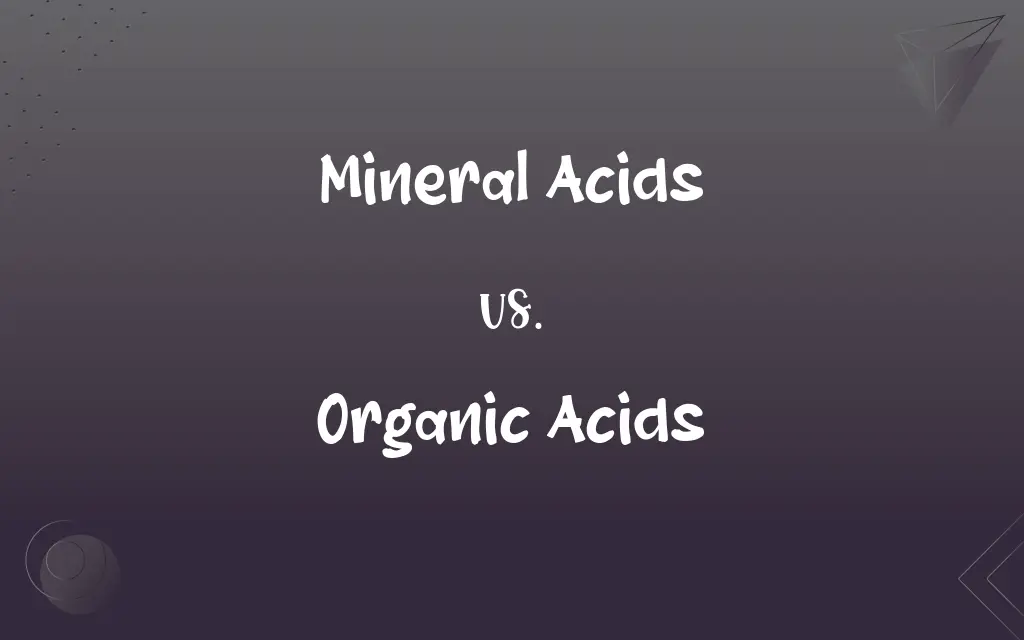Mineral Acids vs. Organic Acids: What's the Difference?
Edited by Aimie Carlson || By Harlon Moss || Updated on October 25, 2023
Mineral acids are inorganic acids derived from mineral sources, while organic acids are carbon-based acids found in living organisms and their processes.

Key Differences
Mineral acids, often referred to as inorganic acids, have their origins from mineral sources. They typically lack carbon in their molecular structure and are usually strong acids. For instance, sulfuric, hydrochloric, and nitric acid are common examples of mineral acids. In contrast, organic acids contain carbon in their molecular structure, often being weaker acids derived from or found within living organisms.
The applications of mineral acids are vast and varied. In industry, mineral acids are used in large-scale processes like metal refining, production of synthetic polymers, and many other chemical processes. Organic acids, on the other hand, have applications more centered around biological and food processes. Examples include citric acid in citrus fruits and acetic acid in vinegar.
When considering the strength of these acids, mineral acids usually stand out as stronger acids. This means they ionize more completely in water, releasing more hydrogen ions. Organic acids are generally weaker, meaning they don't ionize completely in solutions. Thus, solutions of organic acids often have a higher pH than solutions of mineral acids at the same concentration.
Chemically, the production of mineral acids is often from non-biological reactions. For example, sulfuric acid is produced from the oxidation of sulfur. Organic acids, in contrast, are often the result of metabolic pathways in organisms. Fermentation processes, for example, can produce organic acids like lactic acid in dairy products.
In terms of environmental and health considerations, many mineral acids can be quite hazardous, causing burns or being toxic when ingested. They must be handled with care in concentrated forms. Organic acids, while still potentially harmful in large quantities, are often encountered in everyday foods and are generally recognized as safe when consumed in typical amounts.
ADVERTISEMENT
Comparison Chart
Origin
Mineral sources
Living organisms and their processes
Presence of Carbon
Usually lack carbon
Contain carbon
Strength
Typically stronger
Generally weaker
Typical Applications
Industrial processes
Biological and food processes
Examples
Hydrochloric, sulfuric acid
Citric, acetic acid
ADVERTISEMENT
Mineral Acids and Organic Acids Definitions
Mineral Acids
Mineral acids typically do not contain carbon in their molecular structures.
Mineral acids like hydrochloric acid play a vital role in metal refining processes.
Organic Acids
Organic acids play a crucial role in food preservation and flavor enhancement.
Organic acids are commonly used to preserve foods and give them a tangy taste.
Mineral Acids
They find extensive use in various industrial processes and chemical reactions.
Mineral acids are essential in the synthesis of many chemicals and materials.
Organic Acids
Organic acids are carbon-based acids often found within living organisms.
Citric acid, an organic acid, is abundant in citrus fruits like oranges and lemons.
Mineral Acids
These acids are often characterized by their ability to donate protons readily.
The reaction between metals and mineral acids usually releases hydrogen gas.
Organic Acids
These acids typically have a weaker strength compared to mineral acids.
Organic acids like acetic acid don't ionize completely in water.
Mineral Acids
These acids are known for their high strength and complete ionization in water.
When working with mineral acids in a lab, precautions must be taken due to their corrosive nature.
Organic Acids
They are a result of biological and metabolic processes in nature.
Fermentation processes in yogurt produce lactic acid, an organic acid.
Mineral Acids
Mineral acids are inorganic acids derived mainly from non-living, mineral sources.
Sulfuric acid, one of the most common mineral acids, is used in the production of fertilizers.
Organic Acids
Their molecular structure contains the carbon atom, setting them apart from mineral acids.
Organic acids, such as fatty acids, are vital components of cell membranes.
FAQs
Which is stronger, mineral acids or organic acids?
Mineral acids are typically stronger than organic acids.
Are organic acids derived from plants and animals?
Yes, organic acids are often found in living organisms and their metabolic processes.
Are mineral acids dangerous?
Many mineral acids can be hazardous and must be handled with care, especially in concentrated forms.
What's a common source of organic acids?
Fermentation processes are common sources of many organic acids.
Can organic acids be found in foods?
Yes, organic acids like citric and lactic acid are commonly found in foods.
Do all organic acids contain carbon?
Yes, organic acids have carbon in their molecular structures.
Are mineral acids used in industry?
Yes, mineral acids are extensively used in various industrial processes.
Is hydrochloric acid a mineral acid?
Yes, hydrochloric acid is an example of a mineral acid.
Are organic acids safe to consume?
Many organic acids are safe in moderate amounts, but as with all substances, excessive consumption can be harmful.
Why are mineral acids called inorganic?
They are termed inorganic due to their origin from non-living, mineral sources.
How are mineral acids produced?
Mineral acids are often produced through non-biological reactions, like the oxidation of sulfur to form sulfuric acid.
Do organic acids participate in metabolic pathways?
Yes, organic acids are often intermediates or products in various metabolic pathways.
Can organic acids be synthesized in the lab?
Yes, while they occur naturally, organic acids can also be synthesized.
Can organic acids be found in cosmetics?
Yes, certain organic acids are used in cosmetics for various purposes.
Can mineral acids be found in household items?
Yes, some cleaning products may contain diluted mineral acids.
What gives vinegar its sour taste?
The presence of acetic acid, an organic acid, gives vinegar its sour taste.
Are mineral acids used in batteries?
Yes, certain mineral acids like sulfuric acid are used in lead-acid batteries.
What are mineral acids?
Mineral acids are inorganic acids primarily derived from mineral sources.
Do mineral acids contain carbon?
Mineral acids typically lack carbon in their molecular structures.
Are organic acids essential for human health?
Some organic acids play crucial roles in human metabolism and health.
About Author
Written by
Harlon MossHarlon is a seasoned quality moderator and accomplished content writer for Difference Wiki. An alumnus of the prestigious University of California, he earned his degree in Computer Science. Leveraging his academic background, Harlon brings a meticulous and informed perspective to his work, ensuring content accuracy and excellence.
Edited by
Aimie CarlsonAimie Carlson, holding a master's degree in English literature, is a fervent English language enthusiast. She lends her writing talents to Difference Wiki, a prominent website that specializes in comparisons, offering readers insightful analyses that both captivate and inform.































































